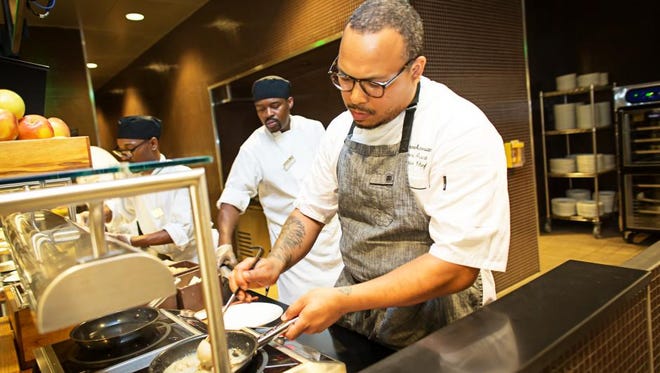Soul food and surprises at Smithsonian museum's Sweet Home Cafe

The menu of the Sweet Home Café, the restaurant inside the National Museum of African American History and Culture features all the usual suspects.
Buttermilk Fried Chicken. Check.
Collard greens. Yep.
Catfish Po’Boy. Of course.
N.Y. artist's precious jewelry in Smithsonian museum gift shop
While the Southern fare makes its requisite appearance – and it’s comforting and all – some of the most delightful, satisfying dishes prepared by Executive Chef Jerome Grant and his team are interpretations of African-American foodways, such as the duck, andouille and crawfish gumbo.
“I don’t know anything about duck in gumbo,” a woman in line said to no one in particular, her face scrunched by skepticism. She left the line and headed for barbecue.
She missed out on the tender strips of pulled duck thigh in the light roux, the sweet crawfish, balanced by generous slices of spicy sausage and okra that still had some snap.
"There are some things what we do that some people don't recognize," Grant said. "We think about Creole food being about seafood, but ducks were in the water, too."

Sweet Home Café's regional menu celebrates culinary traditions in and outside of the South, and takes visitors on the same kind of culinary journey they would find visiting great food neighborhoods like Atlanta’s Buford Highway or Miami's Little Havana. The curatorial approach led by Carla Hall (The Chew) focuses on foods with stories of struggle, freedom and migration.
That's why there are dishes that you might have to Google.
Indiana farm community joins 'absolutely moving' Smithsonian museum opening
The Son of a Gun Stew – which honors the black cowboys on the Western range – may be new to anyone who didn’t grow up near Oklahoma or Texas. "This dish is what people ate as they were migrating west in search of freedom, and what the cooks made for immigrants who came to this country to build the railroads and in search of better lives," Grant explained.
He has modernized the frontier dish that once called for scrap cuts of meat with a velvety short rib.
The Caribbean Pepper Pot, an oxtail stew made with peppers and allspice, might have been ubiquitous for Floridians but is a likely unknown to Midwesterners or Californians. "This is the dish that stirs memories for me," Grant said, noting his father's family who immigrated to Philadelphia from Jamaica.
Even the barbecue takes an unexpected turn, with its Alabama White Sauce, challenging diners' palates.

Grant says the cafe is a restaurant for discovery and suggests that diners taste the Brunswick stew that features rabbit as its main protein. "A lot of people grew up in households where there was chicken, beef and pork – and that was it. But there are other foods that were plentiful. If that's what our people ate, take that trip with us," he said.
That’s the beauty of the Sweet Home Café. Like the museum, which takes visitors past the familiar faces of Civil War and Civil Rights for deeper discovery of the African American experience, the culinary traditions expands diners' expectations to all parts of the United States.
The restaurant menu will change seasonally, and as Grant and culinary historians perfect more dishes. In the coming weeks, Grant hopes to add a version of the shrimp pie once cooked by Nat Fuller – an enslaved Charleston chef – at an interracial reconciliation dinner after the Civil War.
"We want people to taste the food that belongs to those stories," Grant said.
IF YOU GO:
Because of extremely popular demand, visitors must have a timed-entry pass to the National Museum of African American History which are available for free on the museum's website, and in limited quantities at the museum.